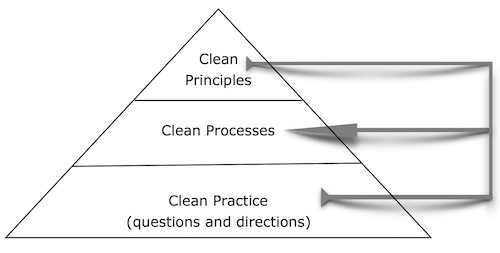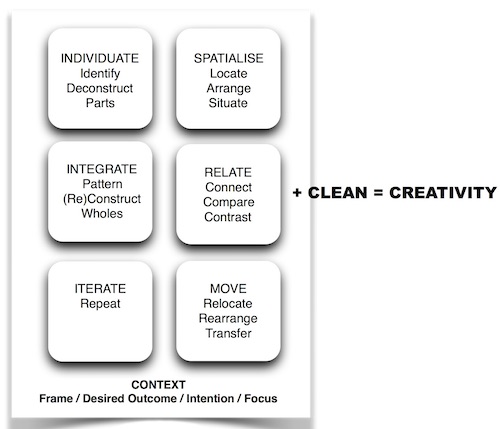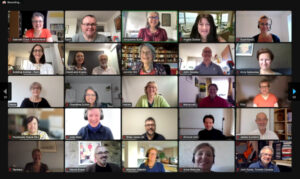Presented to The Developing Group, 28 Nov 2015
Purpose

We have isolated what we call the ‘essential’ routines which include just six clean questions and six clean directions. However, the fun in life is responding to the unexpected and in Clean Space that means responding to an explorer’s (client’s) idiosyncratic process. While we can’t be prescriptive about what to do, we have produced guidance on how to respond. Since this needs be dependent on what happens in the particular conditions that arise in the moment, we’ve called these supplementary options the ‘conditional’ questions and directions.
And sometimes, circumstances dictate that the process itself needs to be varied. Because it is so flexible, and dare we say ‘clean’, there is plenty of scope for innovation. We reviewed many of the variations created since 2002 when Clean Space first made an appearance and identified six features – which together with the set of standard Clean Space directions and questions – can be combined to produce an almost limitless number of new processes (see diagram 2).

Introductory group activity
- Place
- Find
- Return to
- Go to
- Turn
- Move
- Remove
- Separate
- Bring together
- Raise
- Lower
- Rearrange
- We’ll be asking people to move about as part of the process. If at any time you need to adjust your position (including because of what other people are doing) please feel free to do so.
- We will be asking you, “And what do you know here?” and “And now what do you know here?” For the most part, please keep your responses to yourself. At each stage of the activity we will ask for two or three people to report on their experience.
- We have designated this space for the activity, everywhere else in the room is ‘outside’ this space.
1. Consider your relationship to the group.
2. As a group, arrange yourselves in relation to how well you know each other (for this activity, exclude the facilitators, Marian and James).
3. [When the group stops moving around:]
Are you in the right space?
And are you facing in the right direction?
And are you at the right angle?
And are you at the right height?
And is that the right distance between you and others?
And what do you know here?
Note your position in the room.
4. And turn in a different direction.
And what do you know in this direction?
[Optionally, repeat the instruction and question in step 4 twice more.]
5. [Give everyone a number from 1 to 5.]
6. All those with a number 1, remove yourself from the space.
[To the whole group] And now what do you know?
And number 1s, return to where you were.
7. And number 2s, raise yourselves.
8. And number 3s, lower yourselves.
[To the whole group] And now what do you know?
Number 2s and 3s, return to where you were.
9. And number 4s, move to between two other people.
[To the whole group] And now what do you know?
And number 4s, return to where you were.
10. And number 5s, rearrange some of the other people.
[To the whole group] And now what do you know?
11. And everyone separate.
And now what do you know here?
12. And come closer together.
And now what do you know here?
13. And return to your original position.
And now what do you know here?
And what difference does knowing all that make?
And what difference does that make?
And what difference does that make?
Working with a ready-made system
- Members a family or work team
- Stages in a project
- Chapters in a book
- Aspects of a bind
- Thoughts on a topic
- Components of a desired outcome
- Factors of a problem
- Levels in a hierarchy
- Events in a sequence
- Stakeholders in an organisations
- Symbols in a metaphor landscape
- Characters in a story
- Learnings from a training
- Words in a sentence
If so, the explorer can start by identifying a space for each element, and when that’s done, to place him or herself in relation to the elements.
A key difference when working with a set of pre-existing parts of a system compared to the conventional Clean Space, is the lack of a single space for the topic. Instead the network of spaces arranged by the explorer is the topic.
When you start in this way it is as though the network comes ready-formed and so more time can be spent on exploring links and network effects. The downside is that the initial emergent creation of spaces is lost.
Even when the explorer has not come with a prepared system you can invite them to write down six aspects of their topic on separate Post-its and to arrange them around the room and then to find a space for him or herself.
Ready-made System Activity
The following is an advanced activity suitable for facilitators familiar with the essential Clean Space process.
1. Start
Identify a Topic you would like to explore (see list above for examples).
Write/draw on separate Post-its what you already know about the Topic (use as many as you need).
Arrange the Post-its on a table or wall and place each Post-it where it needs to be.
Place yourself where you are in relation to these [gesture to post-its].*
And what do you know here?
* [Optional] Use an Extended Clean Start:
Are you/those in the right place?
Are you/those at the right angle / height / distance (apart)?
Are you/those facing in the right direction?
2. Explore the existing network
Invite the client to:
Know here:
And what do you know here about [name/point to one of the Post-its]?
Know there:
And what does [name/point to one of the Post-its] know?
And what does [name/point to one of the Post-its] know about [name/point to one of the other Post-its]?
Update Knowing:
And now what do you know here?
3. Adjust the network
Use a selection of these additional active spatial verbs:
RAISE / LOWER
And can any of the [Post-its] be raised/lowered?
And can any other [Post-its] be raised/lowered?
And now what do you know?
FURTHER APART / CLOSER
And can any of the [Post-its] be further apart / closer?
And can any other [Post-its] be further apart / closer ?
And now what do you know?
MOVE / REMOVE
And can any of the [Post-its] be moved / removed?
And can any other [Post-its] be moved / removed ?
And now what do you know?
REARRANGED
And can any of the [Post-its] be rearranged?
And can any other [Post-its] be rearranged?
And now what do you know?
4. Extend the network
FIND [Explorer goes to a new space]
And find another space.
And find a space outside of all this [gesture around network].
And what could this space be called?
TURN [said several times in the same space]
And turn and face another direction.
And what do you know in this direction?
5. Complete
And where would you like to complete this?
And what difference does knowing all this make?
And what difference does knowing that make?
When you are ready, collect up your paper and Post-it Notes.








